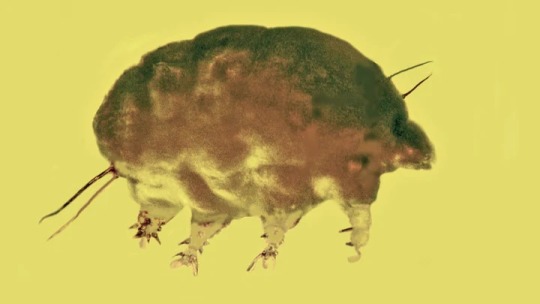#Sialomorpha dominicana
Explore tagged Tumblr posts
Text
Mold Pig (Sialomorpha dominicana) – Tardigrade's Real Cousin

“ The mold pigs can't be placed in any group of currently existing invertebrates — they share characteristics with both tardigrades, sometimes referred to as water bears or moss pigs, and mites but clearly belong to neither group. ”
– George Poinar Jr.
Sialomorpha dominicana, also known as the mold pig, is a panarthropod genus of uncertain affinities discovered in 30-million year old Dominican amber by George Poinar at Oregon State University and Diane R. Nelson at East Tennessee University.
Take Note: All of my drawings and photos of people, animals, plants, mythology, disasters, organizations, events, and more are purely fictitious. These are included in real-life situations and events with fictional characters or creatures that aren't real, be at your own risk. For nationality or indigenous, be advised. Ognimdo.
Etymology
The tiny swines' proposed scientific name, Sialomorpha dominicana, derives from words meaning "Dominican fat hog-shaped" in Greek.
Physiology
It was assigned to a distinct genus and family (Sialomorphidae) and seems to belong to a new phylum. Sialomorpha dominicana is somewhat similar to mites and tardigrades. It grew by molting its exoskeleton and is around 100 µm long. It most likely consumed small invertebrates and fungus, such as mold, as an omnivore. These fossils' anatomical structures and developmental patterns show a period of time when particular animal kinds started to exhibit particular features. Unlike tardigrades and mites, they lack claws on the tips of their legs.
Abilities
The mold pigs shared warm, moist surroundings with pseudoscorpions, nematodes, fungi and protozoa.
Ecology
Coming soon.
Behavior
Coming soon.
Distribution and Habitat
Recently, he and his colleague Diane Nelson of East Tennessee State University came upon several hundred mold pig fossils coated in amber from the Dominican Republic. The specimens date back to the mid-Tertiary period, about 30 million years ago, and would have shared their habitat with pseudoscorpions, nematodes, protozoa, and fungi, the authors said.
Gallery
Coming soon.
Reference
#ognimdo2002#earth responsibly#science fantasy#earth#ibispaint art#art ph#tardigrade#Sialomorpha dominicana#sialmorpha#dominican republic#extinct#paleoillustration#paleontology#paleoart#haiti#invertebrates#ibis paint x
10 notes
·
View notes
Photo

You’ve Heard Of Water Bears, But How About These Ancient Mould Pigs?
Newly discovered prehistoric creatures don't fit into any known animal group
by George Dvorsky - October 9, 2019
An analysis of 30-million-year-old amber has resulted in the discovery of a previously unknown microscopic creature from the Cenozoic period. Bearing a resemblance to tardigrades (aka water bears), these now-extinct “mould pigs,” as they’ve been dubbed, are unlike anything seen before.
Introducing Sialomorpha dominicana, a newly discovered microinvertebrate found locked in amber from the Dominican Republic. Its discoverers, paleobiologist George Poinar Jr. from Oregon State University and invertebrate zoologist Diane Nelson from East Tennessee State University, have dubbed the creature a “mould pig” in honour of its portly, porcine appearance and its diet, which consisted primarily of fungi. Details of the discovery were recently published in Invertebrate Biology.
The 83-year-old Poinar is no stranger to working with fossils trapped in amber. His 1982 research paper gave sci-fi author Michael Crichton the idea of extracting dinosaur DNA from insects trapped in amber, as portrayed in the film Jurassic Park...
Read more: https://www.gizmodo.com.au/2019/10/youve-heard-of-water-bears-but-how-about-these-ancient-mold-pigs/
Sources:
https://en.wikipedia.org/wiki/Sialomorpha
https://onlinelibrary.wiley.com/doi/abs/10.1111/ivb.12265
109 notes
·
View notes
Text
Виявилено рештки стародавнього мікроорганізму, якому понад 30 млн років
Виявилено рештки стародавнього мікроорганізму, якому понад 30 млн років
Біологи з США розповіли про стародавніх родичів тихоходок, рештки яких вони знайшли у Домінікані.
У покладах бурштину, яким близько 30 млн років, вчені виявили схожі на тихоходок мікроорганізми Sialomorpha dominicana, які мають дещо іншу будова тіла.
Давня комашка. Біологи виявили у Домінікані мікроорганізм, якому понад 30 млн років https://techno.nv.ua/ukr/popscience/kaynozoy-vcheni-viyavili-mik…
View On WordPress
0 notes
Text
schimmelschweine und bärtierchen
Meine “Lieblingstiere” bekommen Konkurrenz: Anfang Oktober gingen Berichte durchs Internet, dass Wissenschaftler in 30 Mio Jahre altem Bernstein eine neue Tiergattung entdeckt haben, die ein bissl an die Bärtierchen (oder Milben) erinnern. Und das Spannendste ist, dass die sogenannten Schimmelschweine (mold pig) Sialomorpha dominicana offenbar eine ganz neue, dh bisher unbekannte ganz alte Tierart ist.
0 notes
Text
科學家發現困在琥珀中的“黴菌豬” 距今約3000萬年

“黴菌豬”與緩步動物(水熊等)具有一些共同特徵,但它們自己也有著一些獨特的特點。 Poinar將這種無脊椎動物正式命名為“ Sialomorpha dominicana”,其“ sialomorpha”源自希臘語中的“肥豬”和“形狀”。
Poinar在周一的一份聲明中說道: “ 我們時不時地會在專門的棲息地中發現小的、易被破壞的、以前未知的化石無脊椎動物。有時,像這個案例一樣,也保留了數百萬年前原始棲息地的一部分。”
Poinar分析了琥珀後,發現“黴菌豬”大多數時候以真菌為食,並在蛻皮過程中長出了外骨骼。 “黴菌豬”是神秘的。 Poinar表示:“我們不知道Sialomorpha族群起源於何時,持續了多長時間,或者今天是否有後代活著。”
.(tagsToTranslate)科學探索(t)科學家發現困在琥珀中的“黴菌豬” 距今約3000萬年(t)kknews.xyz
from 科學家發現困在琥珀中的“黴菌豬” 距今約3000萬年 via KKNEWS
0 notes
Text
“Cerdos gordos dominicanos”: nueva especie de invertebrado fue encontrada en ámbar de hace 30 millones de años
“Cerdos gordos dominicanos”: nueva especie de invertebrado fue encontrada en ámbar de hace 30 millones de años
Fotos: Oregon State University Los animales fueron asignados a una nueva familia, género y especie y fueron llamados Sialomorpha dominicana, traducidos del griego como “cerdo gordo”. Informalmente, los científicos los apodaron “cerdos mohos” debido a su apariencia y dieta.Paleontólogos estadounidenses han descrito una nueva familia, género y especie de invertebrados microscópicos que vivieron…
View On WordPress
0 notes